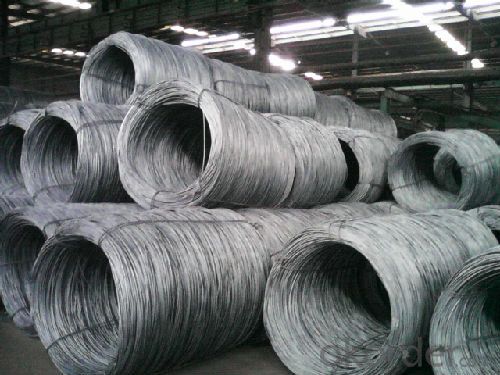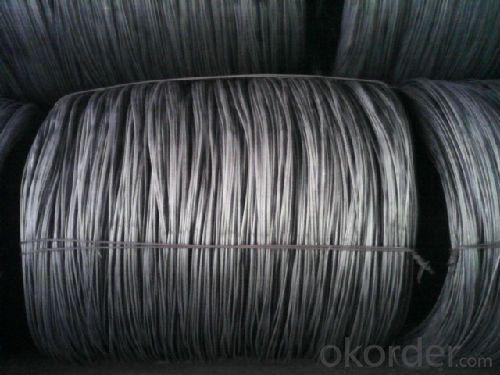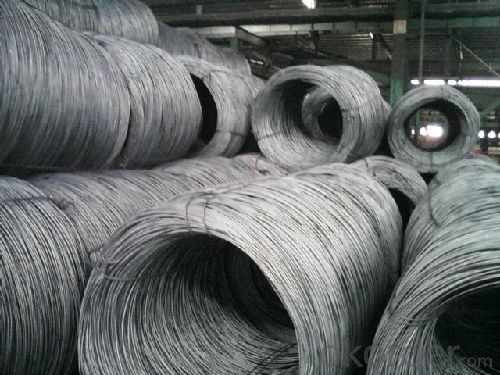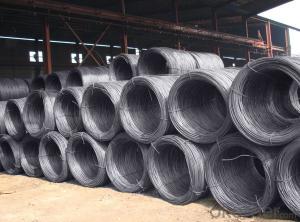Steel Wire Rod China Manufacturer Hot Rolled in Coils
- Loading Port:
- Tianjin
- Payment Terms:
- TT or LC
- Min Order Qty:
- 30 m.t.
- Supply Capability:
- 30000 m.t./month
OKorder Service Pledge
OKorder Financial Service
You Might Also Like
Product Description:
OKorder is offering Steel Wire Rod China Manufacturer Hot Rolled in Coils at great prices with worldwide shipping. Our supplier is a world-class manufacturer of steel, with our products utilized the world over. OKorder annually supplies products to European, North American and Asian markets. We provide quotations within 24 hours of receiving an inquiry and guarantee competitive prices.
Product Applications:
Steel Wire Rod China Manufacturer Hot Rolled in Coils are ideal for structural applications and are widely used in the construction of buildings and bridges, and the manufacturing, petrochemical, and transportation industries.
Product Advantages:
OKorder's Steel Wire Rod China Manufacturer Hot Rolled in Coils are durable, strong, and resist corrosion.
Main Product Features:
· Premium quality
· Prompt delivery & seaworthy packing (30 days after receiving deposit)
· Corrosion resistance
· Can be recycled and reused
· Mill test certification
· Professional Service
· Competitive pricing
Product Specifications:
1.Standard: AISI,ASTM,BS,DIN,GB,JIS
2.Wire Gauge: 5.5~14mm
3.Model Number: Q195, Q235, SAE1006, SAE1008
4.MOQ:25MT
Grade | Chemical Composition(%) | |||||
C | Mn | Si | S | P | B | |
SAE1006B | 0.03~O.07 | ≤0.32 | ≤0.30 | ≤0.045 | ≤0.040 | >0.0008 |
Mechanical properties | ||||||
Yield strength(N/mm2) | Tensile strength(N/mm2) | Elongation(%) | ||||
250-280 | 350-380 | ≥32 | ||||
Grade | Chemical Composition(%) | |||||
C | Mn | Si | S | P | B | |
SAE1008B | 0.10max | 0.3~O.50 | 0.15max | 0.050max | 0.040 max | 0.0008 min |
Mechanical properties | ||||||
Yield strength(N/mm2) | Tensile strength(N/mm2) | Elongation(%) | ||||
≥195 | 315-430 | ≥30 | ||||
Grade | Chemical Composition(%) | |||||
C | Mn | Si | S | P | B | |
Q195B | 0.06~O.12 | 0.25~O.50 | ≤0.30 | ≤0.050 | ≤0.045 | >0.0008 |
Mechanical properties | ||||||
Yield strength(N/mm2) | Tensile strength(N/mm2) | Elongation(%) | ||||
≥195 | 315-430 | ≥33 | ||||
Grade | Chemical Composition(%) | |||||
C | Mn | Si | S | P | B | |
Q235B | 0.12~O.2 | 0.3~O.701 | ≤0.30 | ≤0.045 | ≤0.045 | >0.0008 |
Mechanical properties | ||||||
Yield strength(N/mm2) | Tensile strength(N/mm2) | Elongation(%) | ||||
235 | 375-500 | ≥26 | ||||
FAQ:
Q1: Why buy Materials & Equipment from OKorder.com?
A1: All products offered byOKorder.com are carefully selected from China's most reliable manufacturing enterprises. Through its ISO certifications, OKorder.com adheres to the highest standards and a commitment to supply chain safety and customer satisfaction.
Q2: How do we guarantee the quality of our products?
A2: We have established an advanced quality management system which conducts strict quality tests at every step, from raw materials to the final product. At the same time, we provide extensive follow-up service assurances as required.
Q3: How soon can we receive the product after purchase?
A3: Within three days of placing an order, we will begin production. The specific shipping date is dependent upon international and government factors, but is typically 7 to 10 workdays.
Q4: What makes stainless steel stainless?
A4: Stainless steel must contain at least 10.5 % chromium. It is this element that reacts with the oxygen in the air to form a complex chrome-oxide surface layer that is invisible but strong enough to prevent further oxygen from "staining" (rusting) the surface. Higher levels of chromium and the addition of other alloying elements such as nickel and molybdenum enhance this surface layer and improve the corrosion resistance of the stainless material.
Q5: Can stainless steel rust?
A5: Stainless does not "rust" as you think of regular steel rusting with a red oxide on the surface that flakes off. If you see red rust it is probably due to some iron particles that have contaminated the surface of the stainless steel and it is these iron particles that are rusting. Look at the source of the rusting and see if you can remove it from the surface.
Images:




- Q:How is steel wire rod used in the production of wire ropes for marine applications?
- Steel wire rod is used in the production of wire ropes for marine applications as it serves as the raw material for manufacturing the individual wires that are twisted together to form the rope. The steel wire rod undergoes a series of processes including drawing, heat treatment, and galvanizing to enhance its strength, flexibility, and corrosion resistance. These wire ropes are then utilized in various marine applications such as ship mooring, lifting heavy loads, and securing offshore structures due to their high tensile strength and durability in harsh marine environments.
- Q:How is steel wire rod used in the manufacturing of wire rope assemblies for lifting equipment?
- Steel wire rod is used in the manufacturing of wire rope assemblies for lifting equipment as it serves as the primary material for constructing the individual wires that make up the rope. The steel wire rod is carefully selected for its high tensile strength and durability, ensuring the wire rope has the necessary strength and resilience to safely lift and support heavy loads. The wire rod is first drawn into the desired diameter and then twisted and braided together to form the wire rope, which is then further processed and assembled with fittings and hardware to create the complete wire rope assembly used in lifting equipment.
- Q:What are the safety precautions to be taken while handling steel wire rod?
- To avoid accidents or injuries when dealing with steel wire rods, it is crucial to adhere to specific safety measures. Consider the following important precautions: 1. Personal Protective Equipment (PPE): It is vital to wear suitable PPE, such as protective gloves, safety glasses, and steel-toed boots. This equipment will safeguard against cuts, bruises, and eye injuries. 2. Correct Lifting Methods: To prevent strain or back injuries, employ proper lifting techniques while handling steel wire rods. Lift with your legs, not your back, and refrain from twisting movements when lifting or carrying the rods. 3. Secure Storage: Store steel wire rods in a designated, well-organized, and secure area. This will prevent them from falling or rolling, which could cause harm. 4. Clear Pathways: Keep pathways free from obstructions, ensuring a safe and unobstructed route for transporting the rods. This will minimize the risk of tripping or slipping accidents. 5. Inspection for Defects: Prior to handling steel wire rods, thoroughly inspect them for any defects or sharp edges. Remove any damaged or defective rods from use to prevent injuries. 6. Proper Handling Equipment: Utilize appropriate handling equipment, such as forklifts or trolleys, when moving or transporting steel wire rods. Ensure that the equipment is in good working condition and operated by trained individuals. 7. Collaboration and Communication: When working in a team, effectively communicate with your colleagues to avoid accidents. Employ clear signals or verbal cues to coordinate movements and ensure everyone is aware of their surroundings. 8. Sufficient Lighting: Guarantee that the work area is well-lit to provide clear visibility and minimize the risk of accidents due to inadequate lighting conditions. 9. Training and Awareness: Implement thorough training for all personnel involved in handling steel wire rods. Educate them about potential hazards, safe handling techniques, and emergency procedures. 10. First Aid Preparedness: Maintain a well-stocked first aid kit and ensure that employees are trained in basic first aid to promptly address any injuries. By adhering to these safety precautions, you can effectively reduce the risk of accidents, injuries, and damage when handling steel wire rods. Always prioritize safety and take necessary measures to protect yourself and others in the workplace.
- Q:How is steel wire rod used in the manufacturing of jewelry?
- Steel wire rod is commonly used in the manufacturing of jewelry as it provides strength and durability to delicate pieces. It is often used as a base material for creating intricate designs, such as wire wrapping or beading, serving as a foundation that holds gemstones, beads, or other decorative elements securely in place. Additionally, steel wire rod can be shaped, bent, and twisted to create unique jewelry components like clasps, jump rings, or chains, offering versatility and creative possibilities for jewelry designers.
- Q:How is steel wire rod used in the production of wire mesh for industrial sieving?
- Wire mesh for industrial sieving relies heavily on steel wire rod, which plays a vital role in its production. This mesh finds widespread application in industries like mining, construction, and agriculture, where it is used to separate and classify materials based on their size and shape. To create wire mesh, the steel wire rod undergoes a series of manufacturing steps, transforming it into a suitable form. The rod is typically subjected to wire drawing, a process that involves passing it through a series of dies to reduce its diameter and increase its length. As a result, the wire becomes thin and elongated. Once the wire rod has been drawn, it is either woven or welded together to form the wire mesh. Weaving involves interlacing the wires in a crisscross pattern, creating a strong and durable structure. Conversely, welding involves fusing the wires at their intersections using heat or pressure, resulting in a solid and stable mesh. The choice between weaving and welding depends on specific requirements. Weaving is ideal for producing wire mesh with smaller openings and finer mesh sizes, while welding is preferable for larger openings and heavier wire diameters. The steel wire rod used in wire mesh production offers various advantages for industrial sieving. Firstly, steel is a highly durable and robust material, capable of withstanding harsh environments and heavy loads. This ensures that the wire mesh remains structurally intact even when subjected to constant material impact during the sieving process. Additionally, steel wire rod provides excellent tensile strength, enabling the wire mesh to maintain its shape and resist deformation under tension. This is particularly important for high-pressure sieving applications or situations where the mesh needs to be tightly stretched over a frame. Furthermore, steel wire rod can be coated or treated to enhance its resistance to corrosion, abrasion, and other forms of wear and tear. This prolongs the lifespan of the wire mesh, making it suitable for long-term industrial use. In conclusion, steel wire rod is a crucial component in the production of wire mesh used for industrial sieving. Its versatility, durability, and strength make it an ideal raw material for creating wire mesh capable of withstanding rigorous sieving applications in various industries.
- Q:What are the common applications of cold heading quality and oil tempered steel wire rod?
- The common applications of cold heading quality steel wire rod include the manufacturing of fasteners such as bolts, screws, and rivets. It is also used in the production of automotive parts, machinery components, and construction materials. Oil tempered steel wire rod, on the other hand, finds its common applications in springs, suspension systems, and other high-strength and high-performance applications where resistance to fatigue and durability are important factors.
- Q:What are the common standards for steel wire rod?
- The common standards for steel wire rod include specifications for chemical composition, mechanical properties, dimensions, and surface finish. These standards are set by organizations such as ASTM International, ISO, and national standards bodies. They ensure consistency and quality in the production and use of steel wire rod across different industries and applications.
- Q:What are the different heat treatments applied to steel wire rod?
- Some of the different heat treatments applied to steel wire rod include annealing, quenching and tempering, normalizing, and case hardening.
- Q:What are the different types of steel wire rod coatings used for anti-corrosion properties?
- Steel wire rod coatings are commonly used to prevent corrosion. There are various types of coatings available for this purpose. 1. Zinc Coatings: Zinc coatings, like galvanized coatings, are widely used for their anti-corrosion properties. These coatings create a protective layer of zinc on the steel wire rod surface, acting as a barrier against corrosion. Zinc coatings can be applied through hot-dip galvanizing or electroplating. 2. Aluminum Coatings: Another type of coating used for anti-corrosion is aluminum coatings. These coatings can be applied through hot-dip aluminizing or thermal spraying. They form a protective layer that prevents contact between the steel wire rod and corrosive substances. 3. Epoxy Coatings: Epoxy coatings, a type of organic coating, are commonly used for anti-corrosion purposes. They are applied as a liquid and then cured to create a hard and durable protective layer on the steel wire rod surface. Epoxy coatings offer excellent resistance against corrosion and can withstand harsh environments. 4. Polymer Coatings: Polymer coatings, such as polyethylene or polypropylene coatings, are frequently used for anti-corrosion properties. These coatings are typically applied through extrusion or powder coating. Polymer coatings provide a protective layer that is resistant to chemicals, moisture, and other corrosive elements. 5. Ceramic Coatings: Ceramic coatings are highly resistant to corrosion and wear. They are applied through thermal spraying or chemical vapor deposition. Ceramic coatings create a hard and dense layer on the steel wire rod surface, offering excellent protection against corrosion. Choosing the right coating depends on factors such as the environment, operating conditions, and desired level of corrosion resistance. Each type of coating has its own advantages and limitations, so it is crucial to select the most suitable one for long-term anti-corrosion protection of the steel wire rod.
- Q:How is steel wire rod used in the production of wire baskets for storage?
- Steel wire rod is used in the production of wire baskets for storage as it serves as the main material for creating the basket's structure. The wire rod is typically bent, twisted, or welded into the desired shape to form the basket's framework. Its strength and durability make it suitable for holding various items securely, while its flexibility allows for easy customization and design. Additionally, the steel wire rod can be coated or treated to enhance its corrosion resistance, ensuring the longevity of the wire basket.
1. Manufacturer Overview |
|
|---|---|
| Location | |
| Year Established | |
| Annual Output Value | |
| Main Markets | |
| Company Certifications | |
2. Manufacturer Certificates |
|
|---|---|
| a) Certification Name | |
| Range | |
| Reference | |
| Validity Period | |
3. Manufacturer Capability |
|
|---|---|
| a)Trade Capacity | |
| Nearest Port | |
| Export Percentage | |
| No.of Employees in Trade Department | |
| Language Spoken: | |
| b)Factory Information | |
| Factory Size: | |
| No. of Production Lines | |
| Contract Manufacturing | |
| Product Price Range | |
Send your message to us
Steel Wire Rod China Manufacturer Hot Rolled in Coils
- Loading Port:
- Tianjin
- Payment Terms:
- TT or LC
- Min Order Qty:
- 30 m.t.
- Supply Capability:
- 30000 m.t./month
OKorder Service Pledge
OKorder Financial Service
Similar products
New products
Hot products
Hot Searches
Related keywords




























